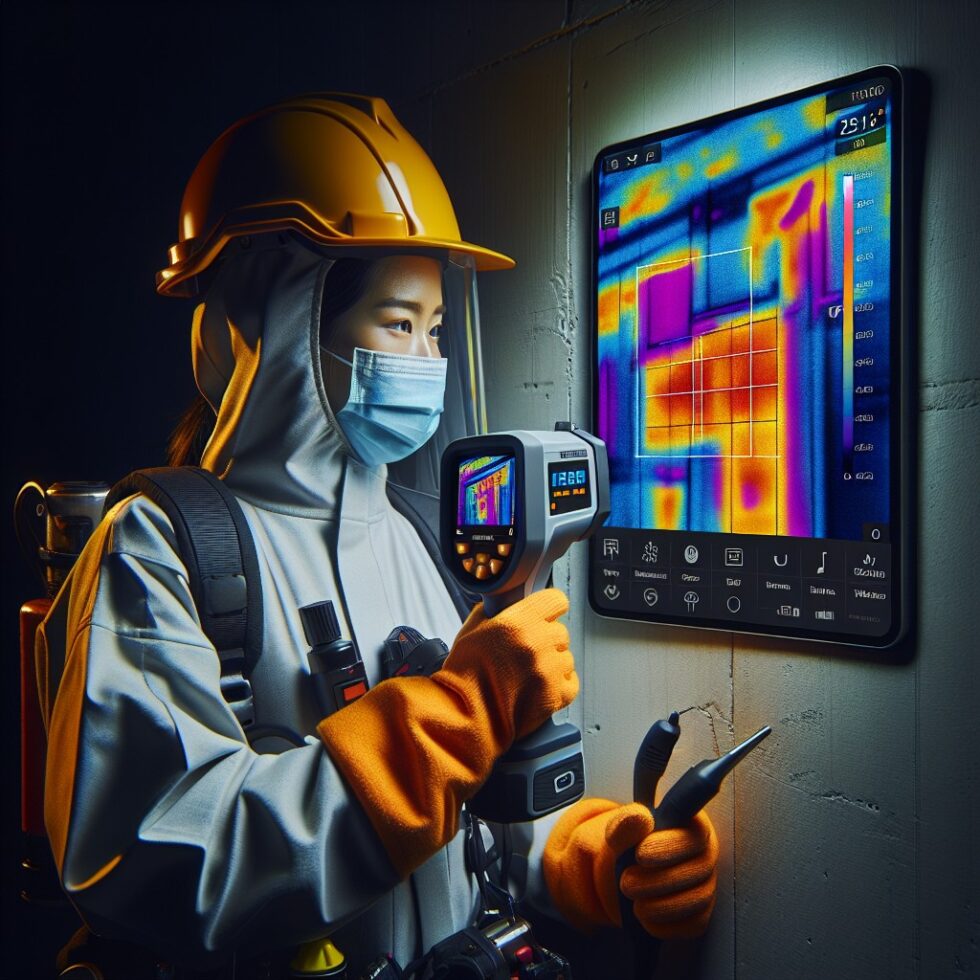
Thermal cameras are no longer rare lab tools. Today, you can clip one onto a phone, borrow a handheld from a hardware store, or book a pro with high‑end gear. Yet many first‑time users take a few dramatic pictures, then stop. The results look impressive, but they don’t always translate into decisions: Where is that draft really entering? Which circuit actually needs attention? Is that damp spot new or old?
This guide skips the hype and focuses on how to use infrared imaging to solve real problems. You will learn what the camera actually measures, how to pick the right model, and the field techniques that separate “cool pictures” from confident fixes. We’ll cover home projects, small‑team workflows, and common pitfalls—so your next heat map becomes a plan, not just a screenshot.
What Thermal Cameras Actually See
Thermal cameras detect infrared radiation emitted by surfaces and convert it into a temperature map. They don’t see through walls or around corners. They don’t reveal heartbeats from across the room. They create an image of surface temperature differences, which are clues about what’s happening underneath.
Emissivity: Your New Favorite Word
Emissivity describes how efficiently a surface emits infrared radiation. A matte painted wall (high emissivity) is straightforward to measure. A shiny stainless steel fridge (low emissivity) reflects the environment and misleads your camera. If your camera reports the wrong emissivity, the number next to that bright spot may be wrong—even if the pattern is useful.
- High emissivity (~0.95): matte paint, human skin, electrical tape, rubber, many plastics.
- Low emissivity (~0.10-0.40): polished metals, glossy foil, some ceramics, glass.
Field tip: To measure a low‑emissivity surface, apply a piece of matte black electrical tape and measure the tape instead. Or paint a removable dot of flat black paint on non‑critical surfaces during tests (with permission).
Resolution and NETD: Seeing the Subtle
Two specs matter more than most: sensor resolution and NETD (noise‑equivalent temperature difference). Higher resolution captures more detail. Lower NETD means the camera can distinguish smaller temperature differences—useful for detecting faint drafts or early‑stage electrical heating.
- Resolution: Common entry levels range from 80×60 up to 320×240. For building diagnostics, 160×120 is a practical minimum; 320×240 or higher is better.
- NETD: Look for ≤50 mK (0.05°C) for subtle gradients. ≤30 mK is excellent but usually costs more.
Frame rate also matters if you want smooth video or are scanning moving objects. Many consumer models lock to 9 Hz due to export controls. That’s fine for stills and slow pans. For faster processes or detailed video, 30 Hz and above is better.
Radiometric vs. Non‑Radiometric Images
A radiometric image stores temperature data for every pixel. You can change palettes and analyze individual pixel values later. A non‑radiometric image is just a colored picture; the temperatures are baked in. When in doubt, choose radiometric. It makes collaboration and re‑analysis far easier.
Choosing the Right Thermal Camera
You have three main form factors today: smartphone attachments, handheld units, and specialized systems (tripod, drone, industrial).
Phone Attachments: Portable and Affordable
USB‑C or Lightning thermal attachments are compact and great for quick surveys. The best models now offer up to 256×192 resolution, reasonable NETD, and basic radiometric capture. Their main limits are narrow lenses, fixed focus, and lack of ruggedization.
Good for: Apartment heat checks, small home inspections, electronics troubleshooting, travel toolkits.
Handheld Units: Balanced and Rugged
Handheld cameras cover 160×120 to 640×480, with better lenses, focus options, and dedicated buttons you can use with gloves. Many include laser pointers, integrated visible cameras for alignment, and onboard reporting. If you’re serious about buildings or electrical work, start here.
Good for: Regular building diagnostics, facilities maintenance, electrical and HVAC inspections.
Specialized Systems: When You Need Scale
Tripod‑mounted cameras stabilize long scans, useful for façades or steady time‑lapse. Drone‑mounted systems cover roofs, solar arrays, and hard‑to‑reach infrastructure quickly. These setups often support higher frame rates and swappable lenses (wide, normal, telephoto).
Good for: Commercial roofs, solar PV arrays, heat loss mapping across large buildings, search and rescue (trained professionals).
Specs That Actually Matter
- Resolution: 160×120 is workable; 320×240+ is ideal for detail.
- NETD: ≤50 mK for subtle gradients.
- Field of View (FOV): Wide FOV for rooms; narrower FOV for distant targets.
- Focus: Fixed focus is simplest. Manual or autofocus is better for varied distances.
- Temperature range: Ensure the range covers your application. Electrical inspections often need higher ranges.
- Radiometric capture: Essential for analysis and reporting.
- Software: Look for easy palette changes, emissivity adjustment, spot and box tools, and export to CSV/PDF.
Field Techniques That Turn Pictures into Proof
If you only learn one section, make it this one. Technique beats raw specs more often than not.
Create a Temperature Difference
To reveal insulation gaps or air leaks, you need a temperature gradient between indoors and outdoors. A 10°C (18°F) difference is a good target. In winter, heat the interior briefly. In summer, cool it. Leaks and missing insulation show up as streaks or patches that depart from the surroundings.
Control Reflection and Emissivity
- Use matte tape on shiny surfaces to get reliable readings.
- Be aware of “false hot spots” caused by reflections of your own body, lights, or the sky.
- Angle the camera slightly; avoid normal incidence on reflective surfaces.
Understand Moisture Signatures
Thermal cameras do not directly see water. They reveal temperature patterns caused by moisture’s thermal behavior. Damp materials often appear cooler because of evaporation. The pattern may be irregular and spread with gravity. Confirm with a pin or pinless moisture meter, not just the camera.
Use Reference Points and Notes
Add visible markers—sticky notes, tape arrows, or a clipboard—to orient future viewers. Use the camera’s annotation tools to set spot temperatures and boxes for min/max/avg. Capture a visible‑light photo of the same scene; the overlay helps others find the exact location later.
Electrical Inspections: Focus on Delta‑T
For electrical panels, you’re looking for components running hotter than identical ones under similar load. A breaker that’s 20°C hotter than peers is suspect. Productivity tip: scan first with a wide palette to find candidates, then zoom or move closer for a focused shot with proper emissivity. Always follow lockout/tagout procedures and keep safe distances.
HVAC and Airflow
Use thermal imaging to verify supply and return temperatures, check for uneven duct insulation, and find blockages. Visualize radiant heating loops in floors, and confirm balanced heating after repairs. Switch palettes to one that emphasizes mid‑range differences (e.g., “Iron” or “Rainbow” for HVAC checks) and lock your temperature scale to avoid shifting colors between shots.
Automotive Checks
Find dragging brakes, uneven tire wear (indirectly via heat at the tread right after driving), clogged radiators, and misfiring cylinders (exhaust headers). Use a narrower FOV or move closer. Keep emissivity high with matte tape where safe. Beware of hot moving parts.
Repeatability Over Drama
Dramatic colors are fun. Repeatable results are better. Use consistent settings: fixed emissivity for similar surfaces, a locked temperature span, and the same distance and angle when comparing before/after repairs. When in doubt, capture a short video and export frames for analysis.
Home Projects You Can Do This Weekend
Here are practical scans that convert into real fixes:
- Door and window drafts: Perform a slow perimeter scan on a cold morning. Mark leaks with painter’s tape. Later, apply weatherstripping, then rescan to confirm even temperatures.
- Attic insulation gaps: On a frosty day, scan ceiling intersections and around can lights. Look for heat bridges at framing. Add insulation and sealed covers for recessed fixtures where allowed.
- Underfloor heating mapping: Turn the system on for 20 minutes. Scan to locate loops. Create a photo overlay map and label tiles for easy reference before drilling or mounting.
- Shower and roof moisture checks: After rain or a shower, scan ceilings below bathrooms and roof penetrations. Cool patterns that linger may indicate moisture. Confirm with a moisture meter.
- Fridge and freezer diagnostics: Scan door seals and evaporator areas. Look for warm spots along gaskets. Realign or replace seals if you see persistent leaks.
Workflows for Teams and Small Businesses
Facilities teams, home inspectors, and contractors can standardize their thermal workflow to save time and improve trust with clients.
Set a Default Palette and Measurement Tools
Choose a palette per use case. For building envelopes, a high‑contrast palette (e.g., “Grayscale” with warm highlights) helps. For electrical work, use palettes that emphasize high temperatures (e.g., “White Hot” or “Iron”). Add default spot and box overlays in every capture and document emissivity and reflected temperature settings.
Capture Both Visible and Thermal
Side‑by‑side visible and thermal images reduce confusion and callbacks. Many cameras can store both in one file. If yours can’t, plan a consistent order (visible first, thermal second) and keep filenames matched by timestamp. Use radiometric formats whenever possible for later analysis.
Organize by Location and System
Create a folder structure like Building → Floor → Room → System (e.g., electrical, HVAC, envelope). Name files with date and basic descriptor (2025‑03‑Kitchen‑NorthWall‑Draft.jpg). Metadata reduces time spent hunting for the “one shot” you need.
Turn Captures into Reports
Most vendors offer software to annotate images and generate PDFs. Include:
- Location and context (weather, indoor/outdoor temperatures, time).
- Emissivity settings and any reference materials (tape, paint).
- Marked areas with temperatures, plus “peer” comparisons for electrical scans.
- Recommended actions with estimated effort and cost ranges.
Integrate with Maintenance Tools
If you use a CMMS (maintenance software), attach key thermal images to work orders. Record baseline scans after repairs. Over time, you’ll build a library of “normal” versus “abnormal” signatures for your site. That makes trending—and early detection—possible.
Limits, Pitfalls, and Safety
Thermal imaging is powerful, but it has clear limits. Know them and you’ll avoid expensive mistakes.
It’s Not a Medical Device
Do not use consumer thermal cameras to diagnose medical conditions. Skin temperature is influenced by many factors. Leave medical thermography to trained clinicians with specialized protocols.
Reflections and “See‑Through” Myths
Thermal cameras do not see through walls, wood, or concrete. They detect surface temperature differences. Reflective surfaces can show hot or cold “ghosts” of the environment. If an area looks suspicious, confirm with another method: moisture meter, IR thermometer (on a taped patch), or physical inspection.
Convection Can Mislead
Warm air rises and cool air sinks. Convection patterns near vents or windows can create streaks that look like leaks. Correlate with airflow direction and check with smoke pencils, incense sticks, or tissue strips to confirm air movement.
Electrical Safety First
Panels and equipment can be dangerous. Observe clearance rules, wear PPE as required, and avoid touching energized parts. If you’re not trained, hire a pro for energized inspections.
Weather Matters
Sun exposure heats surfaces unevenly. Rain cools them. Wind scrubs away temperature differences. For building envelope scans, aim for early morning or late evening with stable conditions. Document the weather in your report to explain patterns.
Budget and Buying Guide
If you’re choosing your first camera, match your expectations and budget to typical price tiers:
Entry Level (Phone Attachments and Basic Handhelds)
- Resolution: 80×60 to 256×192
- NETD: ~50–100 mK
- Use: Quick home checks, hobby electronics, basic HVAC visualization
- Tip: Select a model with radiometric images and decent software support
Mid‑Range Handhelds
- Resolution: 160×120 to 320×240
- NETD: ≤50 mK
- Use: Building inspections, facilities MRO, routine electrical surveys
- Tip: Manual focus and interchangeable palettes make a big difference
Professional Systems
- Resolution: 320×240 to 640×480 (and above)
- NETD: ≤30 mK
- Use: Commercial roofs, solar farms, industrial lines, drone surveys
- Tip: Invest in lenses, training, and reporting workflows, not just pixels
Rent or Borrow for Special Jobs
Before buying a high‑end camera, rent one for a weekend to test your use case. Many tool libraries and rental shops now carry thermal imagers. You’ll learn what specs and features actually matter to your work.
Accessories That Pay Off
- Matte black electrical tape for emissivity control
- Moisture meter to confirm damp spots
- Laser thermometer for quick spot checks on taped areas
- Tripod for time‑lapse or detailed façade scans
- Extra batteries or power bank for long sessions
Making Sense of Palettes and Scales
Palettes map temperature to color. They don’t change the underlying data, but they change what your eye notices. Choose palettes that support your goal:
- Grayscale/White‑Hot: Clean, good for reports and side‑by‑side with visible images.
- Iron/Rainbow: High contrast, good for finding anomalies fast.
- Blue‑Red: Makes hot spots obvious for electrical work.
Lock the temperature span when capturing a series. If the camera auto‑scales each shot, colors can shift even if temperatures haven’t changed, making comparisons unreliable.
From Image to Action: A Simple Decision Framework
Turn your findings into a plan with a straightforward decision process:
1) Is the anomaly repeatable?
Rescan under similar conditions. If it disappears, it may have been transient (sun, wind, appliance cycle). If it persists, move to confirmation.
2) Can you confirm with a second method?
Use a moisture meter, pressure test, or direct thermometer reading on a taped patch. For electrical work, compare similar components under similar loads.
3) Is it significant enough to act now?
Define your threshold. For drafts, a 3–5°C difference along a seam you can feel may justify sealing. For electrical, a 15–25°C delta between similar components often warrants further assessment. Document your criteria.
4) Will the fix be verifiable?
Plan a follow‑up scan after the repair. Use the same camera, settings, distance, and ambient conditions if possible. Keep both images side‑by‑side in your report. Verification closes the loop.
Case Snapshots
Apartment Draft Hunt
A tenant with a clip‑on camera scanned on a windy evening and found a clear cold streak beneath a window stool. After adding foam backer rod and silicone sealant, a second scan showed the streak gone and the room felt less drafty. Simple tool, reliable outcome.
Facility Electrical Panel Sweep
During a monthly thermal walk, a tech noticed one breaker 22°C hotter than its neighbors under normal load. The team scheduled a shutdown, found a loose lug, and corrected it before failure. Baseline images from previous months helped justify the work order.
Hidden Bathroom Leak
A cool patch slowly spreading on a ceiling below a bathroom appeared in a time‑lapse thermal series. A moisture meter confirmed elevated moisture content. A tiny supply line leak was fixed before the ceiling failed.
Training and Continuous Improvement
Formal training helps, especially for commercial work. Even a short online course can accelerate your learning. Build your own “thermal library” of typical patterns in your home or facility. Label examples as “normal” and “actionable.” Share them with your team, so everyone learns to spot the right clues.
Most of all, keep the workflow simple. Standardize your checklists, capture settings, and report templates. Consistency beats one‑off hero shots.
Summary:
- Thermal cameras map surface temperature differences; they don’t see through walls.
- Emissivity and reflections can mislead. Use matte tape on shiny surfaces to measure accurately.
- Resolution and NETD matter. Aim for 160×120 or better and ≤50 mK for building work.
- Choose radiometric images to analyze later with spot and box tools.
- Create a temperature difference to reveal leaks and insulation gaps.
- Confirm moisture with a meter and electrical anomalies with peer comparisons.
- Lock temperature scales for consistent comparisons and cleaner reports.
- Standardize team workflows: palettes, annotations, filenames, and report templates.
- Use a simple decision framework: repeat, confirm, threshold, verify.
- Rent before buying high‑end gear and invest in accessories that improve accuracy.





